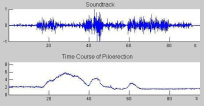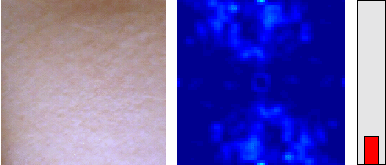|
|
Optical recording of
|
Contact:
|
| [Start] [Why goosebumps] [Interest in goosebumps] [Recording Device] [Analysis Software] [Spectral Analysis] || [Team] | ||
From skin pictures to quantitative goosebump analysis
The skin pictures taken by our recording system are analyzed with a set of Matlab routines (called Gooselab) in terms of a two-dimensional Discrete Fourier Transform (DFT). The animated GIF to the right shows a part of skin with goosebumps coming and going and the resulting Fourier analysis in false color rendering. Please note the two red peaks close to the center that appear whenever goosebumps are present in the skin picture. The height of these peaks give a quantitative measure of the strength of the goosebumps visible in the skin picture.The recording system and the corresponding software has proven to be very sensitive to even slightest traces of the occurrence of goosebumps. It can give exact quantitative information on the dynamics of the coming and going of the goosebumps, related precisely to the timing of the stimulus.
The Matlab routines of Gooselab are available for scientific purposes (GNU license):
Gooselab V1.21 (2009-07-13)
Gooselab V1.21 Linux-Version (2011-07-08; provided by Sebstian Jentschke, FU Berlin)
The analysis involves the following functionality:
* Load raw or compressed video files (*.avi) or pictures (various formats)
* Associate stimulus files (e.g., audio files)
* Automatically identify event marker (green LED marker within video file)
* Analyze video material (including various options on the image properties and DFT frequency range)
* Normalize analysis result and identify baseline and piloerection periods
* Save project Matlab file encompassing all analysis variables for further post-analysis
* Export gifs of the analysis result
For further details see the references below or contact the authors:
Benedek, M. & Kaernbach, C. (2011). Physiological correlates and emotional specificity of human piloerection. Biological Psychology, 86(3), 320-329. doi: 10.1016/j.biopsycho.2010.12.012.
Benedek, M., Wilfling, B., Lukas-Wolfbauer, R., Katzur, B. H. & Kaernbach, C. (2010). Objective and continuous measurement of piloerection. Psychophysiology, 47 (5), 989-993. doi: 10.1111/j.1469-8986.2010.01003.x
 |
 |
| Screenshot of the goosebump analysis software. | Time course of the coming and going of goosebumps. |
 |
| Animated GIF showing a part of skin getting goosebumps, and the resulting Fourier analysis. The "Goosometer" displays the derived goosebump value. |




